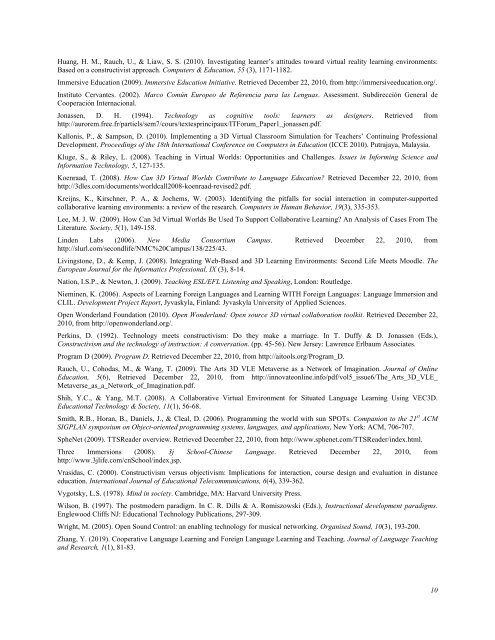October 2011 Volume 14 Number 4 - Educational Technology ...
October 2011 Volume 14 Number 4 - Educational Technology ...
October 2011 Volume 14 Number 4 - Educational Technology ...
You also want an ePaper? Increase the reach of your titles
YUMPU automatically turns print PDFs into web optimized ePapers that Google loves.
Huang, H. M., Rauch, U., & Liaw, S. S. (2010). Investigating learner’s attitudes toward virtual reality learning environments:<br />
Based on a constructivist approach. Computers & Education, 55 (3), 1171-1182.<br />
Immersive Education (2009). Immersive Education Initiative. Retrieved December 22, 2010, from http://immersiveeducation.org/.<br />
Instituto Cervantes. (2002). Marco Común Europeo de Referencia para las Lenguas. Assessment. Subdirección General de<br />
Cooperación Internacional.<br />
Jonassen, D. H. (1994). <strong>Technology</strong> as cognitive tools: learners as designers. Retrieved from<br />
http://aurorem.free.fr/partiels/sem7/cours/textesprincipaux/ITForum_Paper1_jonassen.pdf.<br />
Kallonis, P., & Sampson, D. (2010). Implementing a 3D Virtual Classroom Simulation for Teachers’ Continuing Professional<br />
Development. Proceedings of the 18th International Conference on Computers in Education (ICCE 2010). Putrajaya, Malaysia.<br />
Kluge, S., & Riley, L. (2008). Teaching in Virtual Worlds: Opportunities and Challenges. Issues in Informing Science and<br />
Information <strong>Technology</strong>, 5, 127-135.<br />
Koenraad, T. (2008). How Can 3D Virtual Worlds Contribute to Language Education? Retrieved December 22, 2010, from<br />
http://3dles.com/documents/worldcall2008-koenraad-revised2.pdf.<br />
Kreijns, K., Kirschner, P. A., & Jochems, W. (2003). Identifying the pitfalls for social interaction in computer-supported<br />
collaborative learning environments: a review of the research. Computers in Human Behavior, 19(3), 335-353.<br />
Lee, M. J. W. (2009). How Can 3d Virtual Worlds Be Used To Support Collaborative Learning? An Analysis of Cases From The<br />
Literature. Society, 5(1), <strong>14</strong>9-158.<br />
Linden Labs (2006). New Media Consortium Campus. Retrieved December 22, 2010, from<br />
http://slurl.com/secondlife/NMC%20Campus/138/225/43.<br />
Livingstone, D., & Kemp, J. (2008). Integrating Web-Based and 3D Learning Environments: Second Life Meets Moodle. The<br />
European Journal for the Informatics Professional, IX (3), 8-<strong>14</strong>.<br />
Nation, I.S.P., & Newton, J. (2009). Teaching ESL/EFL Listening and Speaking, London: Routledge.<br />
Nieminen, K. (2006). Aspects of Learning Foreign Languages and Learning WITH Foreign Languages: Language Immersion and<br />
CLIL. Development Project Report, Jyvaskyla, Finland: Jyvaskyla University of Applied Sciences.<br />
Open Wonderland Foundation (2010). Open Wonderland: Open source 3D virtual collaboration toolkit. Retrieved December 22,<br />
2010, from http://openwonderland.org/.<br />
Perkins, D. (1992). <strong>Technology</strong> meets constructivism: Do they make a marriage. In T. Duffy & D. Jonassen (Eds.),<br />
Constructivism and the technology of instruction: A conversation. (pp. 45-56). New Jersey: Lawrence Erlbaum Associates.<br />
Program D (2009). Program D. Retrieved December 22, 2010, from http://aitools.org/Program_D.<br />
Rauch, U., Cohodas, M., & Wang, T. (2009). The Arts 3D VLE Metaverse as a Network of Imagination. Journal of Online<br />
Education, 5(6), Retrieved December 22, 2010, from http://innovateonline.info/pdf/vol5_issue6/The_Arts_3D_VLE_<br />
Metaverse_as_a_Network_of_Imagination.pdf.<br />
Shih, Y.C., & Yang, M.T. (2008). A Collaborative Virtual Environment for Situated Language Learning Using VEC3D.<br />
<strong>Educational</strong> <strong>Technology</strong> & Society, 11(1), 56-68.<br />
Smith, R.B., Horan, B., Daniels, J., & Cleal, D. (2006). Programming the world with sun SPOTs. Companion to the 21 st ACM<br />
SIGPLAN symposium on Object-oriented programming systems, languages, and applications, New York: ACM, 706-707.<br />
SpheNet (2009). TTSReader overview. Retrieved December 22, 2010, from http://www.sphenet.com/TTSReader/index.html.<br />
Three Immersions (2008). 3j School-Chinese Language. Retrieved December 22, 2010, from<br />
http://www.3jlife.com/cnSchool/index.jsp.<br />
Vrasidas, C. (2000). Constructivism versus objectivism: Implications for interaction, course design and evaluation in distance<br />
education. International Journal of <strong>Educational</strong> Telecommunications, 6(4), 339-362.<br />
Vygotsky, L.S. (1978). Mind in society. Cambridge, MA: Harvard University Press.<br />
Wilson, B. (1997). The postmodern paradigm. In C. R. Dills & A. Romiszowski (Eds.), Instructional development paradigms.<br />
Englewood Cliffs NJ: <strong>Educational</strong> <strong>Technology</strong> Publications, 297-309.<br />
Wright, M. (2005). Open Sound Control: an enabling technology for musical networking. Organised Sound, 10(3), 193-200.<br />
Zhang, Y. (2019). Cooperative Language Learning and Foreign Language Learning and Teaching. Journal of Language Teaching<br />
and Research, 1(1), 81-83.<br />
10

















